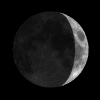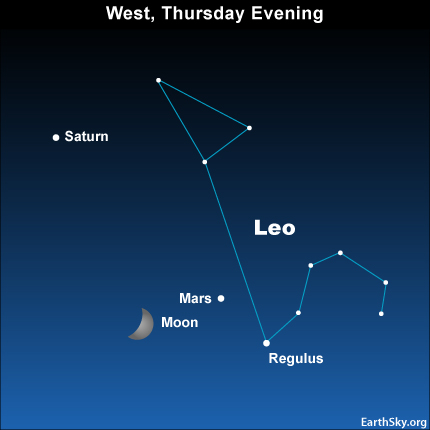Courtesy of EarthSky
A Clear Voice for Science
www.EarthSky.org

 The crescent moon glides by Mars tonight, making it easy to identify the planet, which has been getting dimmer for the past few months. If you face west about an hour after sunset, Mars is the yellow or orange “star” just to the north of the moon. Saturn, very slightly brighter than Mars, is a bit farther from and above the moon.
The crescent moon glides by Mars tonight, making it easy to identify the planet, which has been getting dimmer for the past few months. If you face west about an hour after sunset, Mars is the yellow or orange “star” just to the north of the moon. Saturn, very slightly brighter than Mars, is a bit farther from and above the moon.
Mars is known as the “Red Planet,” but most people do not see it with a truly red color. Instead, it usually appears yellowish or perhaps a rusty orange. In fact, the surface of the planet is an orange red, due to the color of its soil. This color is sometimes modified a bit, as viewed by the human eye from far-off earth, due to bright while polar caps, thin Martian clouds and occasional sand storms. As a result, the view from earth is often of a tiny point of yellow or orange light, rarely if ever actually red. This view gets a bit more complicated (and interesting) when you realize that in fact you are not seeing Mars’ light at all. Mars does not produce its own visible light, but simply reflects sunlight. So the light that you see from Mars tonight left the surface of the Sun about 27.7 minutes earlier, as this is the time it takes a photon to travel 152,039,000 miles from the Sun to Mars, and then 157,626,000 to earth at about 186,000 miles per second! (This light-time figure is good for today, and is different at different times because the varying distances between earth, Mars and the sun.)
Why orange, you may ask. The sun’s light is composed of many colors, which combined appears white. Martian soil (technically, “regolith”) contains large amounts of iron oxides, rust. The molecules of this material absorb the shorter wavelength blue and green photons in sunlight, but reflect the longer wavelengths such as yellow and red. Thus it is the yellow and red light that gets reflected back to earth, resulting in the orange hue.
Written by Larry Sessions
Astronomy Picture of the Day from NASA/JPL
U.S. Naval Observator Astronomical Information center
The York County Astronomical Society
 Print This Post
Print This Post








